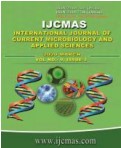


 National Academy of Agricultural Sciences (NAAS)
National Academy of Agricultural Sciences (NAAS)

|
PRINT ISSN : 2319-7692
Online ISSN : 2319-7706 Issues : 12 per year Publisher : Excellent Publishers Email : editorijcmas@gmail.com / submit@ijcmas.com Editor-in-chief: Dr.M.Prakash Index Copernicus ICV 2018: 95.39 NAAS RATING 2020: 5.38 |
A study is conducted through Soil test Crop Response based (STCR) for the desired yield targets of pea in an alluvial soil of two different locations of a village- Persiya, block- Naugharh in Chandauli district during Rabi season2017. For testing of developed fertilizer prescription equation is necessary to demonstrate the effectiveness of technology delivery to the farmers field. To evaluate the validation of fertilizer prescription, experiment was set-up in two locations of Chandauli district, Uttar Pradesh. Soil samples of the selected crop field locations are studied initially for analyzing available N, P, K, EC, pH and organic matter status. Treatments were included as control, farmer practices, general recommended dose of fertilizer and STCR based fertilizer dose with 5 t ha-1 FYM for targetingyield15 and 20 quintal per hectare (q ha-1). The treatments were applied and cultivation practices were carried out periodically and the grain yield was recorded after harvest. With using data on grain yield and fertilizer doses applied, percent increment in yield and benefit cost (B:C) ratio were determined. The results of the experiments indicated that in two locations, the percent achievement of the targeted yield was within±10% variation proving the validity of the equations for prescribing integrated fertilizer doses for pea. The highest per cent increment in yield was recorded in the yield target of 20 q ha-1 (39.43 percent) followed by 15 q ha-1 (9.59 percent) over recommended dose of fertilizers (RDF). The highest mean grain yield recorded in STCR with 5 t ha-1FYM was 20 q ha-1 (1962.5 kg ha-1). The highest benefit: cost ratio recorded in T5 treatment (20 q ha-1) was 5.45 followed by T4 treatment (15 q ha-1) was 4.32. The fertilizer prescription equations developed for pea can be recommended for alluvial soil (Inceptisol) of eastern Utter Pradesh for achieving a yield target of 20 q ha-1 with higher economic return.
 |
 |
 |
 |
 |